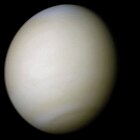Portal:Solar System/Selected article/4
Venus is the second planet from the Sun. It is a terrestrial planet and is the closest in mass and size to its orbital neighbour Earth. Venus is notable for having the densest atmosphere of the terrestrial planets, composed mostly of carbon dioxide with a thick, global sulfuric acid cloud cover. At the surface it has a mean temperature of 737 K (464 °C; 867 °F) and a pressure of 92 times that of Earth's at sea level. These conditions are extreme enough to compress carbon dioxide into a supercritical state close to Venus's surface.
Internally, Venus has a core, mantle, and crust. Venus lacks an internal dynamo, and its weak induced magnetosphere is instead caused by atmospheric interactions with the solar wind. Internal heat escapes through active volcanism, resulting in resurfacing instead of plate tectonics. Venus is one of two planets in the Solar System that have no moons. Conditions perhaps favourable for life on Venus have been identified at its cloud layers. Venus may have had liquid surface water early in its history with a habitable environment, before a runaway greenhouse effect evaporated any water and turned Venus into its present state. (Full article...)

